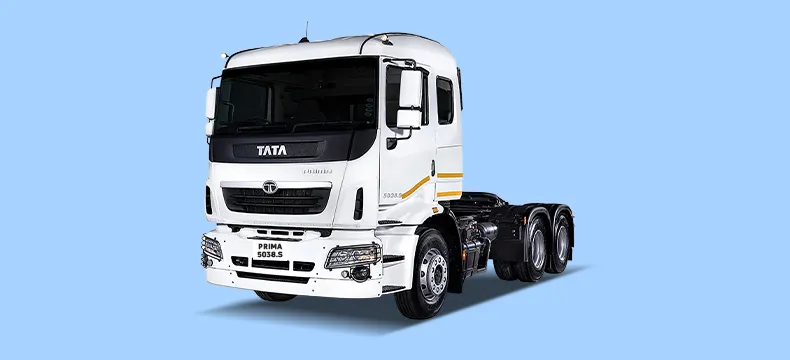4 Dec 2025

Challenges and Solutions for Heavy Commercial Vehicle Dealerships in Kenya
- Tata Motors
- 7 Aug 2024
- COMMERCIAL VEHICLE
Introduction
The heavy commercial vehicle industry is a vital part of Kenya's transport and logistics sector. However, dealerships in this sector face unique challenges that require strategic solutions. In this blog, we will explore the key challenges for heavy commercial vehicle dealerships in Kenya and effective strategies to overcome them.
The heavy commercial vehicle segment which includes trucks, buses, tractors and specialist vehicles, is a major contributor to Kenya's economy. This industry enables movement of goods and people across the country. Heavy commercial vehicle sales in Kenya have been growing steadily over the past decade. However, dealerships face difficulties like complex import regulations, high capital requirements and having to cater to diverse customer needs. Understanding and addressing these pain points is crucial for the success of dealerships.
Challenges Faced by Heavy Commercial Vehicle Dealerships in Kenya
Strict Import Regulations and High Taxes
The import regulations for heavy commercial vehicles in Kenya are complex. Dealers are required to comply with various certification and taxation rules that vary based on vehicle type, size and year of manufacture. High import duties and taxes also make these vehicles expensive for buyers. Simplifying regulations and reducing taxes can help make the process easier for dealers.
High Capital Investment Requirements
Heavy commercial vehicle dealerships require large investments in facilities, inventory, skilled staff and other resources. Dealers must have sufficient working capital to purchase vehicles in bulk, maintain inventory and provide test drives and demonstrations for customers. Access to financing and capital investments is a major hurdle.
Inadequate After-Sales Service and Support
After-sales service and support like servicing, maintenance and repairs are crucial for heavy commercial vehicles. Most dealerships struggle with providing widespread service networks and qualified technicians especially in remote areas. This leads to customer dissatisfaction and can damage brand reputation.
Inconsistent Supply and Demand Cycles
The heavy commercial vehicle market relies heavily on established relationships between manufacturers, dealers and operators. Any disruptions due to financial constraints, production issues or changes in regulations can result in supply-demand imbalances. Proactively managing inventory is a challenge for dealers.
Solutions for Heavy Commercial Vehicle Dealerships in Kenya
1. Streamlining Import Regulations and Taxation:
-
Advocate for Simplified Regulations: Engage with regulatory bodies to streamline import procedures and certification requirements.
-
Lobby for Tax Reductions: Work with industry associations to advocate for reduced import duties and taxes on heavy commercial vehicles.
-
Explore Local Assembly: Utilize local assembly capabilities to reduce dependency on imports and potentially lower costs for customers.
2. Addressing High Capital Investment Requirements:
-
Facilitate Access to Financing: Partner with financial institutions to provide tailored financing solutions for dealership expansions and inventory management.
-
Promote Joint Ventures: Explore partnerships and joint ventures to share capital investment burdens and expand dealership networks.
-
Optimize Inventory Management: Implement efficient inventory management systems to minimize capital tied up in unsold vehicles.
3. Enhancing After-Sales Service and Support:
-
Expand Service Network: Invest in expanding service centers across Kenya, particularly in remote areas, to improve accessibility for customers.
-
Train and Certify Technicians: Establish training programs to certify technicians in specialized heavy commercial vehicle maintenance and repair.
-
Implement Comprehensive Maintenance Plans: Offer comprehensive maintenance plans to ensure vehicles remain in optimal condition throughout their lifespan.
4. Managing Supply and Demand Cycles Effectively:
-
Diversify Supplier Relationships: Develop relationships with multiple suppliers to mitigate risks associated with supply chain disruptions.
-
Monitor Market Trends: Utilize data analytics to forecast demand trends and adjust inventory levels accordingly.
-
Flexible Inventory Strategies: Implement agile inventory management strategies to quickly adapt to fluctuating market demands.
5. Leveraging Local Assembly Capabilities:
-
Tata Motors Has Local Assembly Plant: Utilize existing assembly capabilities in Kenya to assemble parts locally, reducing dependence on imports and supporting local job creation.
-
Promoting Local Job Creation: Tata Motors hire and train local workforce for assembly operations, contributing to economic growth and sustainability.
-
Enhanced Product Customization: Tata Motors offer customized solutions to meet specific customer needs through local assembly capabilities.
Tata Signa
The Tata Signa, available in various configurations such as the 2823.K, is a flagship model in Tata Motors' lineup of medium and heavy commercial vehicles. Here are some key features:
|
Feature |
Description |
|
Engine Options |
Powerful engines with high torque and fuel efficiency, suitable for long hauls and demanding terrains. |
|
Payload Capacity |
Capable of carrying heavy loads with ease, making it ideal for construction, logistics, and other heavy-duty applications. |
|
Comfort and Safety |
Driver-centric design with comfortable cabins, ergonomic controls, and advanced safety features to ensure driver well-being and cargo security. |
|
Technological Advancements |
Equipped with advanced telematics systems for real-time monitoring, enhancing operational efficiency and reducing downtime. |
|
Environmental Compliance |
Compliant with Kenyan and international emissions standards, ensuring environmental sustainability and regulatory adherence. |
Conclusion
In conclusion, while the heavy commercial vehicle market in Kenya poses several challenges, strategic approaches such as specialized customer service, flexible financing, local partnerships, and effective marketing can position dealerships for success. With the right strategies and a focus on quality products like the Tata Signa, dealerships can capitalize on the growing demand for heavy-duty trucks in Kenya's vibrant economy. By adapting to market dynamics and leveraging opportunities, dealerships can navigate challenges and thrive in this competitive industry landscape.
Understanding these dynamics is crucial for anyone aiming to succeed in the heavy commercial vehicle dealership sector in Kenya. Whether you are an investor, a fleet manager, or a business owner looking to expand your operations, the insights provided here offer a strategic blueprint for navigating this exciting but challenging market.
- Tags



















